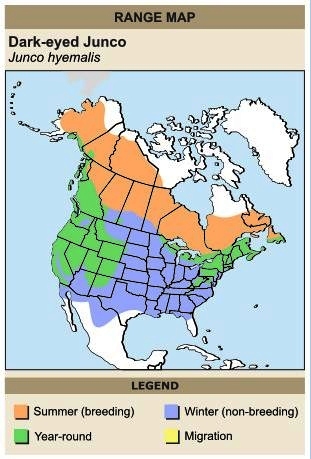|

Medium
sparrow with considerable geographic color variation,
although all exhibit a pink bill, dark eyes, white belly, dark-centered
tail with white outer feathers. Short flight with white outer tail feathers
flashing, alternates several rapid wing beats with wings pulled to sides.

|
DARK-EYED
JUNCO
Junco hyemalis
PASSERIFORMES
Sparrows (Emberizidae)
Range and Habitat
Breeds from Alaska east across Canada to Newfoundland, and south to
the mountains in Mexico and Georgia. Spends winters south to the Gulf
coast and northern Mexico; vagrant in Iceland, British Isles, continental
Europe, and east Siberia. Preferred habitats include openings and edges
of coniferous and mixed woods. In the winter, frequents fields, roadsides,
parks, and suburban gardens.
The adult male Dark-eyed Junco has a black hood, chestnut-brown back,
white underparts and buff-brown flanks.
SOUND: "dit", "tsick", "tchet"
The Dark-eyed Junco was the most common feeder bird in North America
during the 1996-1997 Project FeederWatch season.
They mainly eat insects and seeds.
However, they will sometimes eat their own droppings.
A group of sparrows has many collective nouns, including a "crew",
"flutter", "meinie", "quarrel", and "ubiquity"
of sparrows.
The Dark-eyed Junco has a large range, spanning across Mexico, the United
States and many island nations to which the bird is native, as well
as many parts of Europe.
This bird prefers forest and shrubland ecosystems, though it has been
known to reside in rural gardens. The global population of this bird
has not been determined or quantified, but it does not appear to meet
population size or decline criteria that would necessitate inclusion
on the IUCN Red List. The current evaluation status of the Dark-eyed
Junco is Least Concern.
|